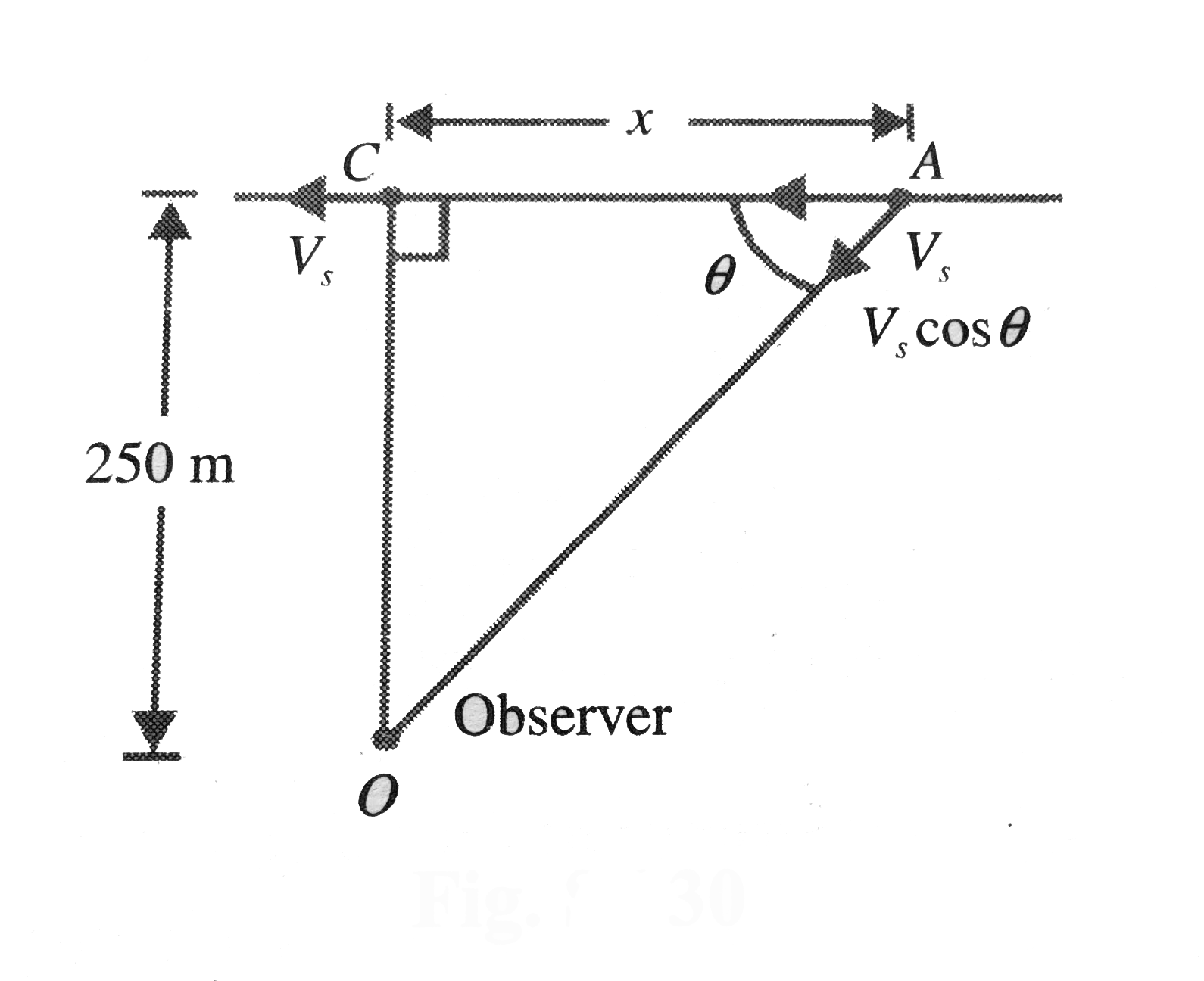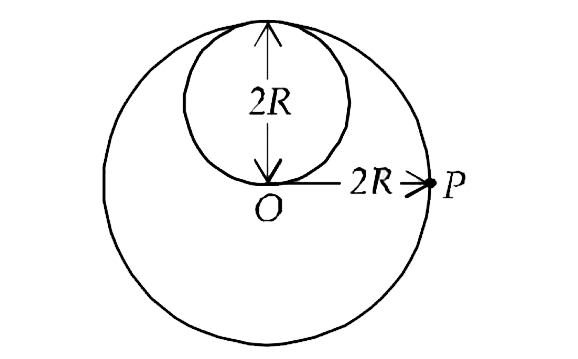A source of sound with natural frequency f0=1800Hz moves uniformly along a straight line separated from a stationary observer by a distance l=250m. The velocity of the source is equal to η=0.80 fraction of the velocity of the sound.
Q. Find the frequency of osund received by the observer at the moment when the source gets closest to him.

2000Hz
6000Hz
3000Hz
5000Hz
The correct Answer is:C

Let the source be moving along the strainght line AC and observer be located at O, as shown. Let the velocity of sound in air be v. The velocity of source is ηv.
Let the sound wave received by the observer at the moment when the source is closest to the observer (at C) be emitted by the source when it was at point A.
Therefore, by the time source travels from A to C, the sound wave travels from A to O. If this interval is t,AC=ηct and AO=vt. Velocity of approach of source when it is at A.
vS=(ηv)cosθ=(ηv)(ACAO)=ηv(ηvtvt)=η2v
When the sound wave emitted by the source at A reaches the staionary observer at O, it will receive the frequency
f=f0(vv−vS)=f0(vv−n2v)
=f01−η2=18001=(0.8)2=5000Hz
Topper's Solved these Questions
- SOUND WAVES AND DOPPLER EFFECTBook:CENGAGE PHYSICSChapter:SOUND WAVES AND DOPPLER EFFECTExercise:Integer
Explore 16 Videos
- SOUND WAVES AND DOPPLER EFFECTBook:CENGAGE PHYSICSChapter:SOUND WAVES AND DOPPLER EFFECTExercise:Assertion-Reasoning
Explore 24 Videos
- RIGID BODY DYNAMICS 2Book:CENGAGE PHYSICSChapter:RIGID BODY DYNAMICS 2Exercise:Interger
Explore 2 Videos
- SUPERPOSITION AND STANDING WAVESBook:CENGAGE PHYSICSChapter:SUPERPOSITION AND STANDING WAVESExercise:Comprehension Type
Explore 5 Videos
Similar Questions
The average power transmitted across a cross section by two sound waves moving in the same direction are equal. The wavelength of two sound waves are in the ratio of 1:2, then find the ratio of their pressure amplitudes.
View SolutionStatement I: A tuning fork is considered as a source of an acoustic wave of a single frequency as marked on its body. Statement II: The tuning fork cannot produce any of its harmonics due to its special nature of construction.
View SolutionA lamina is made by removing a small disc of diameter 2R from a bigger disc of uniform mass density and radius 2R, as shown in the figure. The moment of inertia of this lamina about axes passing though O and P is IOandIP respectively. Both these axes are perpendicular to the plane of the lamina. The ratio IPIO ot the nearest integer is

View SolutionA string of length L, fixed at its both ends is vibrating in its 1st overtone mode. Consider two elements of the string of the same small length at positions l1=0.2Landl2=0.45L from one end.
If K1andK2 are their respective maximum kinetic energies,then
View SolutionA source of sound of frequency 1000HZ moves unifornly along a straight line with velocity 0.8 times velocity of sound . An observer is located at a distance l=250m from this line. Find
(a) the frequency of the sound at instant when the source is closest to the observer.
(b) the distance of the source when he observer no change in the frequency.
View SolutionA source of sound with natural frequency f_0=1800Hz moves uniformly along a straight line separated from a stationary observer by a distance l=250m . The velocity of the source is equal to eta=0.80 fraction of the velocity of the sound. Q. Find the frequency of osund received by the observer at the moment when the source gets closest to him.
View SolutionA source of sound with natural frequency f_0=1800Hz moves uniformly along a straight line separated from a stationary observer by a distance l=250m . The velocity of the source is equal to eta=0.80 fraction of the velocity of the sound. Q. The distance between the source and the observer at the moment when the observer receives a frequency f=f_0 is
View SolutionA source of sound S is moving with a velocity of 50m//s towards a stationary observer. The observer measures the frequency of the source as 1000 Hz. What will be the apparent frequency of the source as 1000 Hz. What will be the apparent frequency of the source when it is moving away from the observer after crossing him? The velocity of the sound in the medium is 350m//s
View SolutionA source of sound emitting a note of frequency 200 Hz moves towards an observer with a velocity v equal to the velocity of sound. If the observer also moves away from the source with the same velocity v, the apparent frequency heard by the observer is
View SolutionA source of sound of frequency 1.8kHz moves uniformly along a straight line at a distance 250m from observer. The velocity of source is 0.8C where C is the velocity of sound. Find out the frequency of sound received by observer (in kHz) at the moment when the source gets closest to him.
View SolutionAn observer moving towards a stationary source observes that the apparent frequency is three times the actual frequency of the source. If the velocity of sound is V, the velocity of the observer would be-
View SolutionA source of sound with natural frequency v_(0) moves uniformly along a straight line separated from a stationary observer by a distance l . The velocity of the source is equal to eta fraction of velocityof sound. Find the frequency of sound received by the observer at the moment when the source gets closest to him and also find the distance between the source and the observer at the moment, when the observer receives a frequency v = v_(0)
View Solutionएक ध्वनि स्रोत एक स्थिर प्रेक्षक से ध्वनि वेग के बराबर वेग से दूर जा रहा है। ध्वनि की आवृत्ति कितनी हो जायेगी?
View SolutionA source of sound with natural frequency n = 1800 Hz moves, uniformly along a straight line separated from a stationary observer by a minimum distance d = 250m. The velocity of the source is equal to 0.8v, v being speed of sound. The frequency of sound received by the observer at the moment when the source gets closest to him is 1000x. Then x
View SolutionA source of sound with natural frequency n = 1800 Hz moves, uniformly along a straight line separated from a stationary observer by a minimum distance d = 250m. The velocity of the source is equal to 0.8v, v being speed of sound. The frequency of sound received by the observer at the moment when the source gets closest to him is 1000x. Then x
View SolutionA source of sound of frequency 1000HZ moves unifornly along a straight line with velocity 0.8 times velocity of sound . An observer is located at a distance l=250m from this line. Find
(a) the frequency of the sound at instant when the source is closest to the observer.
(b) the distance of the source when he observer no change in the frequency.
View Solution
